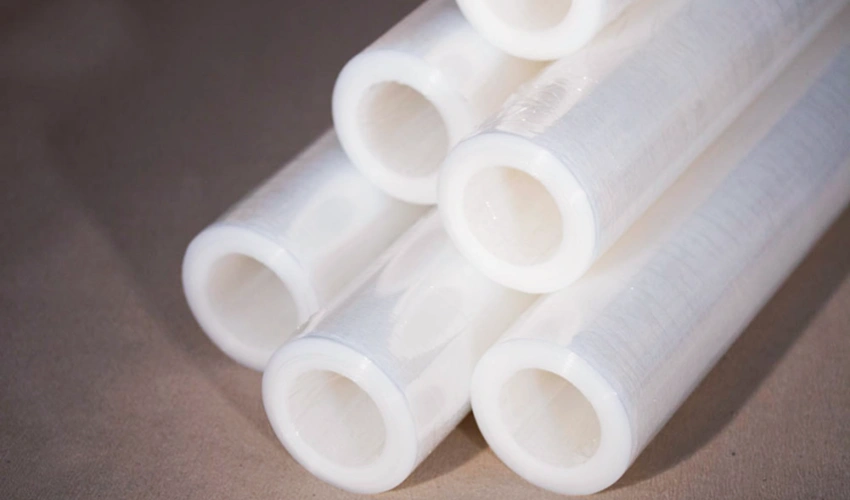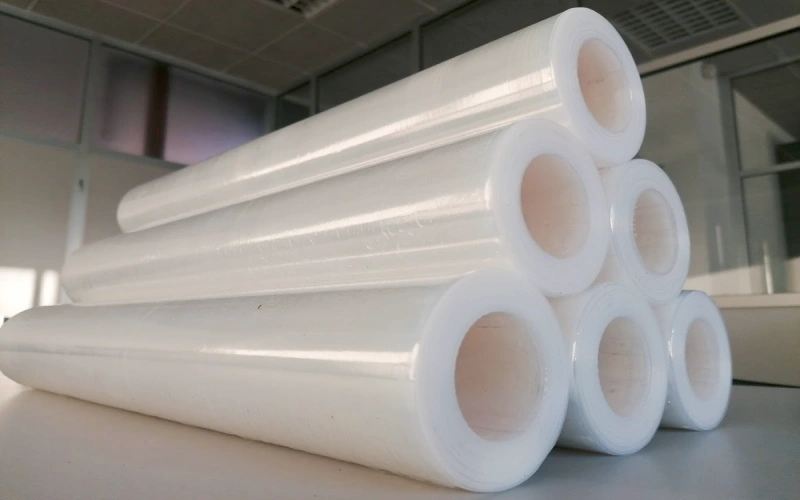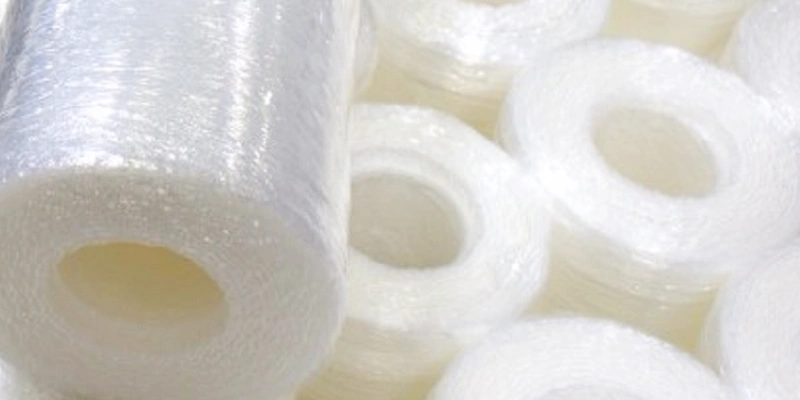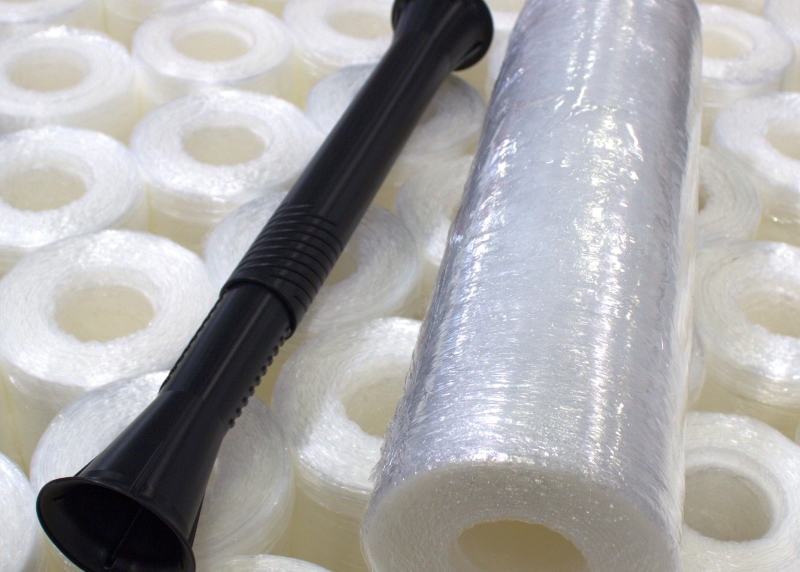
Every year, U.S. businesses spend over $3 billion disposing of packaging waste—much of it from traditional stretch film cores. But what if you could slash those costs and reduce your carbon footprint simultaneously? Enter coreless stretch film, the game-changing solution revolutionizing American logistics and warehousing.
Ready to escape the cardboard core trap? Discover top suppliers, calculate exact savings with our free tool, and claim free samples—your $50,000 packaging overhaul starts here.
Coreless stretch film is a type of stretch wrap material used primarily for packaging and securing loads during transportation or storage. Unlike traditional stretch films, which are wound around a central cardboard or plastic core (typically 3–8 inches in diameter), coreless stretch film eliminates the need for this inner core. This innovative design offers practical, economic, and environmental advantages, making it increasingly popular in industries such as logistics, warehousing, and manufacturing.
Coreless stretch film has emerged as a game-changer in packaging solutions, offering distinct advantages over traditional core-based stretch films. Below is a detailed breakdown of its key benefits, including cost savings, environmental compliance, and efficiency improvements:
Coreless stretch film directly addresses operational expenses by optimizing material usage and logistics:
Coreless stretch film aligns with global sustainability goals and regulatory requirements, such as California AB 1583 (mandating reduced plastic waste) and EU plastic taxes:
Coreless stretch film enhances productivity across manual and automated workflows:
A major logistics company in California switched to coreless stretch film to comply with AB 1583. Results included:
Coreless stretch film is not just a packaging material but a strategic tool for modern businesses. It drives cost savings through lightweight design and material efficiency, ensures compliance with stringent environmental regulations, and boosts operational productivity via automation compatibility. As supply chains face growing pressure to reduce waste and carbon footprints, coreless stretch film offers a scalable, future-ready solution for industries aiming to balance profitability with sustainability.

Coreless stretch film is revolutionizing the packaging industry by addressing critical challenges in cost, sustainability, and operational efficiency. Below is a comprehensive breakdown of its key advantages, supported by practical examples and industry insights:
Coreless stretch film significantly reduces expenses across the supply chain:
Coreless stretch film aligns with global eco-friendly initiatives and regulations:
Coreless stretch film enhances productivity in manual and automated workflows:
Coreless stretch film prioritizes ergonomics and ease of use:
Coreless stretch film adapts to diverse packaging needs:
Coreless stretch film supports evolving industry trends:
A European automotive supplier adopted coreless stretch film and achieved:
Coreless stretch film delivers a compelling blend of economic, environmental, and operational benefits. By eliminating cores, it reduces costs, supports regulatory compliance, and streamlines workflows while maintaining robust load stability. As industries prioritize sustainability and automation, coreless stretch film emerges as a forward-thinking solution for businesses aiming to optimize packaging processes, reduce waste, and enhance supply chain resilience. Its adaptability across sectors—from logistics to retail—ensures it remains a cornerstone of modern packaging strategies.
Coreless stretch film is engineered to deliver high performance while addressing modern packaging demands. Below is a detailed breakdown of its key technical specifications, including material properties, physical dimensions, and performance metrics, based on industry standards and testing methods:
| Parameter | Range/Value | Notes |
|---|---|---|
| Thickness (Gauge) | 12–30 microns (μm) | Thinner films (12–17 μm) for light loads; thicker (20–30 μm) for heavy-duty use. |
| Width | 10–50 cm (4–20 inches) | Narrow widths for hand rolls; wider for machine use. |
| Roll Diameter | 20–30 cm (8–12 inches) | Coreless rolls have a hollow center (no core). |
| Roll Weight | 5–25 kg (11–55 lbs) | Lighter than traditional rolls (15–20% weight reduction). |
| Film Length per Roll | 300–1,500 meters (985–4,920 feet) | Depends on thickness and roll diameter. |
| Parameter | Range/Value | Test Standard | Application Impact |
|---|---|---|---|
| Elongation at Break | 200–500% | ASTM D882 | Higher stretch reduces material usage. |
| Tensile Strength | 20–40 MPa (2,900–5,800 psi) | ASTM D882 | Ensures load stability during transit. |
| Puncture Resistance | 300–800 g/mil | ASTM D5748 | Critical for sharp-edged loads. |
| Tear Resistance | 10–30 N/mm | ASTM D1922 | Prevents film splitting during application. |
| Cling Force | 50–150 g/cm² (one- or two-sided) | In-house cling tests | Ensures layers adhere without slippage. |
| Parameter | Details | |
|---|---|---|
| Operating Temperature | -50°C to 70°C (-58°F to 158°F) | Retains flexibility in cold storage. |
| UV Resistance | Up to 12 months outdoor exposure (with UV additives). | |
| Food Safety | FDA-compliant grades available for direct food contact. | |
| Flammability | Meets UL 94 HB flame retardancy standards. |
A frozen food supplier switched to 20μm UV-stabilized coreless stretch film with the following technical specs:
Results:
Coreless stretch film’s technical parameters—such as thickness, elongation, and puncture resistance—are tailored to meet diverse industrial needs while optimizing cost and sustainability. Its compatibility with automated systems, recyclability, and adherence to global standards make it a versatile choice for industries ranging from logistics to food packaging. When selecting coreless film, always verify specifications against application requirements (e.g., load weight, environmental conditions) to ensure optimal performance.

Coreless stretch film is a versatile packaging solution that addresses unique challenges across diverse sectors. Its lightweight design, material innovations, and customization capabilities make it indispensable in industries ranging from e-commerce to heavy manufacturing. Below is a detailed analysis of its adaptability, supported by real-world applications and case studies:
Key Requirements: Cost-effective, lightweight packaging for small parcels; high-speed automation; reduced shipping waste.
Coreless Film Advantages:
Case Study:
An online retailer handling 10,000 daily shipments adopted 17μm pre-stretched coreless film. Results included:
Key Requirements: FDA-compliant materials; moisture and condensation resistance; temperature stability.
Coreless Film Advantages:
Case Study:
A Midwest cold chain supplier switched to 25μm coreless stretch film with UV and moisture resistance for frozen beef shipments. Outcomes included:
Key Requirements: Durability to protect heavy, sharp-edged components; resistance to oils and chemicals; automation-friendly.
Coreless Film Advantages:
Case Study:
Ford’s Michigan plant integrated 30μm coreless film into its automated packaging line, achieving:
Coreless stretch film’s adaptability across industries stems from its ability to balance performance, cost, and sustainability. In e-commerce, it slashes shipping expenses; in food logistics, it ensures compliance and freshness; in manufacturing, it delivers rugged protection for heavy loads. As industries increasingly prioritize automation and eco-friendly practices, coreless stretch film is poised to become the packaging standard for forward-thinking businesses. Its proven success in partnerships with giants like Ford and innovative cold chain suppliers underscores its role as a critical enabler of efficient, sustainable supply chains.
Coreless stretch film has emerged as a transformative force in the global packaging industry, addressing critical challenges in cost, sustainability, and operational efficiency. Its role extends beyond mere product protection—it is a strategic enabler of modern supply chains, aligning with evolving market demands for greener practices, automation, and cost optimization. Below is a detailed analysis of its pivotal role in shaping the market:
Coreless stretch film directly reduces operational expenses through:
Coreless stretch film is a cornerstone of eco-friendly packaging strategies:
Coreless stretch film is integral to modern automated workflows:
Coreless stretch film’s versatility makes it indispensable across sectors:
Coreless stretch film addresses key trends reshaping the packaging industry:
A multinational retail chain adopted coreless stretch film across 200+ stores, achieving:
Coreless stretch film is not just a packaging material—it is a catalyst for innovation in the global market. By reducing costs, advancing sustainability, and enabling automation, it addresses the triple bottom line of profit, planet, and people. As industries face mounting pressure to adopt greener practices and optimize logistics, coreless stretch film has transitioned from a niche product to a mainstream necessity. Its ability to adapt to diverse sectors—from e-commerce to automotive—positions it as a linchpin of efficient, future-ready supply chains. Companies that embrace coreless technology today are poised to lead in a market where efficiency and sustainability are no longer optional but imperative.
| Parameter | Coreless Stretch Film | Traditional Stretch Film |
|---|---|---|
| Core Material | None (hollow center) | Cardboard/plastic core (3–8 inches diameter) |
| Weight | 15–20% lighter per roll | Heavier due to core |
| Environmental Impact | Reduces plastic waste; recyclable (no core separation) | Generates core waste; recycling requires core removal |
| Transportation Cost | Lower (more rolls per truck) | Higher (bulkier, heavier rolls) |
| Storage Efficiency | 20–30% more compact | Requires more space for cores |
| Material Usage | Up to 15% less plastic per pallet (pre-stretched) | Standard plastic usage |
| Recycling Process | Simplified (100% film, no core) | Complex (core separation needed) |
| Machine Compatibility | Requires adapters for older machines | Compatible with standard dispensers |
| Labor Ergonomics | Lighter rolls reduce fatigue | Heavier rolls may strain workers |
| Stretch Performance | Up to 300% elongation (pre-stretched options) | Standard 200–250% elongation |
| Regulatory Compliance | Aligns with EU/UK plastic taxes, CA AB 1583 | May incur higher plastic taxes |
| Cost Savings | Long-term savings (transport, storage, waste) | Higher recurring costs (cores, disposal) |
| Common Applications | E-commerce, automated lines, cold chains | General manufacturing, low-automation settings |
A Coreless Stretch Film Dispenser is a specialized tool designed to handle rolls of coreless stretch film—film that lacks a traditional cardboard or plastic core. This dispenser optimizes the application of stretch film for securing pallets, bundling goods, or protecting products during transportation and storage. By eliminating the need for a core, it aligns with sustainability goals while improving operational efficiency. Below is an in-depth exploration of its features, benefits, and applications:
The dispenser operates through a simple yet efficient process:
A European retail chain adopted coreless dispensers across its warehouses, achieving:
The Coreless Stretch Film Dispenser is a critical innovation in modern packaging technology. By removing the need for cores, it not only reduces waste and costs but also enhances operational flexibility across industries. Its compatibility with automation, ergonomic design, and environmental benefits make it a future-proof choice for businesses striving to balance efficiency with sustainability. Whether in small warehouses or large-scale logistics hubs, this tool empowers companies to meet evolving supply chain demands while minimizing their ecological footprint.

At PWP Stretch Film, we pride ourselves on being a leading innovator and manufacturer of high-performance coreless stretch film, designed to meet the evolving demands of modern packaging. As pioneers in the industry, we combine cutting-edge technology, sustainable practices, and customer-centric solutions to deliver products that redefine efficiency, cost savings, and environmental responsibility. Here’s how we stand out as your trusted coreless stretch film supplier:
With years of specialized experience, we have mastered the art of producing coreless stretch film that outperforms traditional alternatives. Our proprietary manufacturing process ensures:
As a responsible manufacturer, we prioritize eco-friendly practices:
At PWP Stretch Film, we don’t just supply products—we deliver solutions that empower your business to thrive in a competitive, sustainability-driven market. By choosing us, you invest in innovation, reliability, and a greener future.
Contact us today to discover how our coreless stretch film can transform your packaging process!
[Email: pwpstretchfilm@gmail.com | Website:https://www.pwpstretchfilm.com/]
Coreless stretch film is a type of packaging film that comes without a cardboard core, allowing for a more compact design and easier handling. Unlike traditional stretch film, which requires a core for dispensing, coreless stretch film can be used directly from a roll, eliminating waste and providing greater flexibility in use. This design allows for lighter packaging, which can lead to cost savings in storage and transportation. Additionally, coreless stretch film often has enhanced cling properties and can provide better load stability during transit.
Using coreless stretch film offers several benefits:
Lightweight Design: The absence of a core reduces weight, making transportation more cost-effective.
Reduced Waste: By eliminating the cardboard core, coreless stretch film generates less waste, making it an environmentally friendly option.
Versatile Application: It can be easily used in various industries, from shipping to storage, thanks to its adaptability.
Easy Handling: The roll is easier to manage, and the film is simpler to apply, especially in high-volume environments.

My name is James Thompson, and I’m the editor of this website dedicated to Stretch Film, Pallet Wrap, and Stretch Wrap products.
My passion for packaging began when I noticed the challenges companies face in securing their products efficiently for transportation and storage. This inspired me to delve deep into the world of stretch films and pallet wraps, exploring the latest technologies and best practices.
I aim to provide valuable insights, practical tips, and up-to-date industry trends to assist you in making informed decisions. Whether you’re a small business owner or part of a large corporation, my goal is to support you in optimizing your operations and ensuring your products reach their destination safely.
Thank you for visiting, and I look forward to accompanying you on your journey toward better packaging solutions.
Comments are closed